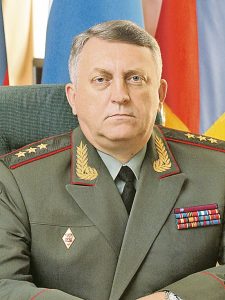Strategic missile forces are the main component of Russia's Strategic Nuclear Forces.
December 17 – RVSN DayColonel-General Sergey KARAKAEV, Commander of the Strategic Missile Forces, tells about the results of the past year, rearmament, development of new combat patrol areas, about the upcoming ballistic missile launches in 2022 and tasks for the coming years.
– Sergey Viktorovich, what are the RVSN today?
Will they retain a two-component structure?– Today, Strategic Missile forces are the main component of Russia's Strategic Nuclear Forces.
The command of the Strategic Missile Forces consistently carries out a set of measures to equip the troops with the latest weapons. The presence of modern missile systems of various types based with intercontinental ballistic missiles in the combat composition of the Strategic Missile Forces makes it possible to reliably solve the entire range of strategic deterrence tasks that ensure the preservation of the sovereignty of our state.
The Strategic Missile Forces include: the command and headquarters of the Strategic Missile Forces, three missile associations, 12 missile formations (from Tver to Irkutsk region), arsenals, the 4th State Central Interspecific Test Site in the Astrakhan region and the 10th Sary-Shagan test site in the Republic of Kazakhstan.
In the future, it is planned to preserve the two-component structure of the missile group. It will include missile formations equipped with mobile and stationary-based missile systems.
– What will be the ratio between stationary and mobile groupings by 2022 and in the longer term?– The ratio of deployed carriers in stationary and mobile groups of the RVSN is approximately equal.
However, due to the presence of heavy and medium-class missile systems "Voevoda" and "Stiletto", the number of nuclear warheads in a stationary grouping is currently somewhat larger than in a mobile one.
In the future, such a quantitative state of the carriers and warheads of the groups as a whole will remain unchanged, which will allow the Strategic Missile Forces to retain the ability to perform the full range of diverse tasks of nuclear deterrence.
– What complexes are in service? Which ones will arrive in the coming years?– Currently, the Strategic Missile Forces are armed with stationary mine-based missile systems: "Avangard", "Voivode", "Stiletto", "Topol-M" and "Yars".
The mobile-based grouping includes mobile ground-based missile systems "Topol", "Topol-M" and "Yars".
In the near future, within the framework of the State Armament Program, the Sarmat complex and the Yars complex with improved combat characteristics will be delivered to the Strategic Missile Forces. A new mobile ground-based missile system is being developed.
– Will the Strategic Missile Forces continue to play a key role in ensuring the country's security in the coming years and in the distant future? What are the prospects for the development of troops?– Strategic missile forces are a ground component of Strategic Nuclear Forces and rightfully occupy a key place in them.
The role in the nuclear triad is undoubtedly determined by the largest number of missile carriers, the number and power of warheads and missile defense systems.
Given the pace of the rearmament of the Strategic Missile Forces with new missile systems, the capabilities of which make it possible to fend off existing and projected threats to military security, the key role of the Strategic missile Forces will remain.
Among the measures of long-term construction and development for the near and medium term, it is planned to maintain the necessary number of launchers in combat condition, including during the rearmament period; the creation of new missile systems and the rearmament of the RVSN grouping on them, the formation of scientific and technical groundwork in the field of creating new types of missile systems.
– What is the combat duty system in the Strategic Missile Forces today?– A well–established and well-established system of combat duty in Strategic Missile Forces - a set of organizational and technical measures that ensure the constant readiness of strategic weapons and troops for immediate missile launches.
Combat duty is the highest form of maintaining combat readiness and the basis for the actions of Missile Troops in daily activities. The combat duty system in the Strategic Missile Forces is a set of activities carried out at all levels of management aimed at maintaining the combat readiness of troops and the ability to complete a combat mission in the shortest possible time.
At this stage of development, the Strategic Missile Forces combat duty system is a well–established mechanism, every detail of which has been tested by time and allows you to operate missile systems with high efficiency.
– What retaliatory measures are envisaged in case of deployment of missile defense infrastructure in close proximity to Russia?– Indeed, the United States continues to actively increase missile defense capabilities in Europe, which may in the future pose a threat to ICBMs located in the European part of the country.
To neutralize these threats, the Strategic Missile Forces have developed and continue to develop effective countermeasures. The new missile systems being developed are necessarily equipped with anti-missile defense means.
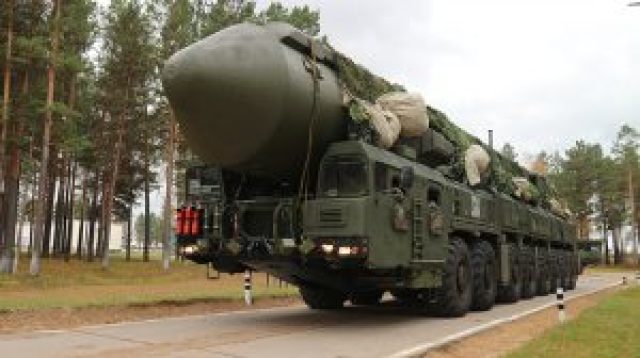
Image source: redstar.ru
– Most recently, the US Missile Defense Agency announced the development of a missile defense system for intercepting hypersonic missiles. Is it possible to create such an "interceptor"? Do I understand correctly that the creation of hypersonic weapons has completely devalued, zeroed out all the latest overseas developments in the field of missile defense?– Yes, at present we can confidently assert that the developed Avangard missile system with a hypersonic gliding cruise combat unit is out of reach for existing and prospective missile defense systems.
After all, such combat units have not only high–speed characteristics - the speed of such blocks exceeds 20 Mach, but also maneuverability, which provides a flight path bypassing the air defense zones and does not allow predicting the final goal of the block. Taking into account such characteristics, the probability of overcoming all existing and promising missile defense systems is almost one hundred percent.
However, do not forget that the development of missile defense systems is also proceeding at a fairly high pace, appropriate research and search for technologies for the development of anti-missiles to defeat hypersonic blocks are being conducted.
There is no doubt that in the foreseeable future, the United States will not only not give up trying to level the capabilities of Russia's Strategic Nuclear Forces, but will also continue to search for and implement new additional ways to solve this problem.
In order to preserve our advantage in this matter, research organizations, with the involvement of enterprises of the military-industrial complex, are developing new systems for overcoming missile defense, including for a missile complex with hypersonic warheads.
– On January 26, 2021, the START Treaty between Russia and the United States was extended for another five years. What does this mean for Strategic Missile Forces?– The Treaty between the Russian Federation and the United States of America on Measures for Further Reduction and Limitation of Strategic Offensive Arms (or the START-3 Treaty) was in force for 10 years and provided for its extension for 5 years.
By mutual agreement of the Parties, the term of the agreement was extended until February 5, 2026 without any changes and additions.
The extension of the START Treaty does not prevent the further development of the Strategic Missile Forces, including the deployment of new missile systems, for example, such as Avangard and Sarmat.
The total number of strategic offensive weapons, the number of inspections and the order of data exchange have not changed.
The total number of launch vehicles limited by the START-3 Treaty: 700 units for deployed ICBMs, SLBMs and heavy bombers; 1,550 units for warheads on deployed ICBMs, SLBMs and nuclear warheads counted for deployed heavy bombers; 800 units for deployed and non-deployed ICBM launchers, SLBMs, deployed and non-deployed heavy bombers.
Every year, until February 5, 2026, American specialists will continue to inspect the facilities of the Strategic Nuclear Forces. According to statistics, the share of inspections carried out at the RVSN facilities is about 70 percent of their total number.
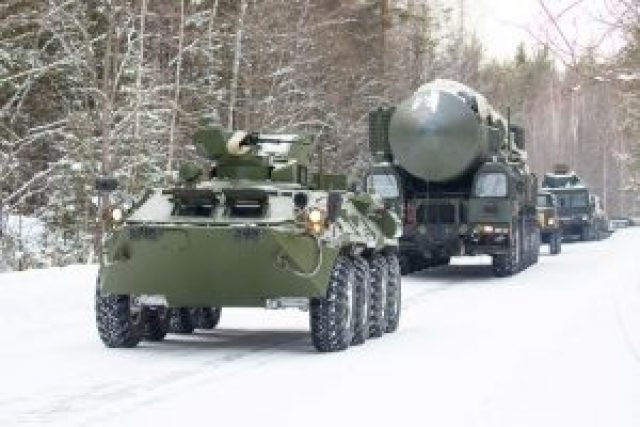
Image source: redstar.ru
– Is it possible to install fundamentally new combat equipment on solid-fuel ICBMs?– Of course, the latest modifications of combat equipment will in the future be installed on new missile systems, including solid-fuel ICBMs.
– How are the contracts for the state defense order implemented in the interests of the Strategic Missile Forces? What new types of weapons and military equipment have been received by the Strategic Missile Forces? What is the current share of modern complexes in the total combat strength of the Strategic Missile Forces? Please evaluate the pace of rearmament of the Strategic Missile Forces in recent years.– In the near future, it is planned to retrofit new models of weapons, military and special equipment of the RVSN units.
In the active phase, the re-equipment of the stationary-based Yars RCSN in the Kozelsky compound continues. Of the eight missile formations equipped with mobile missile systems, six have already completed rearmament.
The existing production rates of strategic missile systems meet the needs of the Strategic Missile Forces. Domestic industrial enterprises maintain the pace of delivery of new missile systems to the troops established by the State Armament Program.
In the period from 2011 to 2021, 21 missile regiments with modern missile systems were put on combat duty. The share of modern missile systems in the group has increased from 38 to 83 percent.
As part of the development of the Yars Missile Defense System, fundamentally new units and systems were created and delivered to the troops, ensuring invulnerability and safety, as well as guaranteed functioning of missile systems. Among them are a remote mine clearance vehicle "Foliage", a combat anti-sabotage vehicle "Typhoon-M", high-speed communication and data transmission systems.
– Has it already become a tradition, summing up, to tell how many re-equipped missile regiments have taken up combat duty this year? Were there such shelves this year? How many missile regiments are equipped with modern strategic missile systems? What is their geography? Which regiments will take up combat duty in 2022?– We are completing the year 2021 by putting on combat duty the next missile regiment of the Kozelsky missile compound with the Yars missile complex in the mine version and the regiment in the Barnaul missile compound with the mobile version of the Yars missile complex.
36 missile regiments are equipped with modern strategic missile systems, 20 of which are mobile ground–based and 16 are stationary-based.
In 2022, we plan to put four missile regiments on duty. Among them are a missile regiment in the Uzhursky missile compound with the Sarmat missile complex, one new regiment in the Yasnensky missile compound with the Avangard missile complex, as well as missile regiments in the Tver and Kirov regions with the Yars mobile ground missile complex.
– At what stage of rearmament is the Uzhur rocket compound being re-equipped with Sarmat missile systems?– Already today, in the Uzhursky missile compound located in the Krasnoyarsk Territory, work has been launched to prepare the main missile regiment for rearmament.
Currently, the reconstruction of the infrastructure of the re-equipped regiment is continuing. Serial equipment manufactured at industrial enterprises has been supplied to the compound since the beginning of 2021, installation of mine launchers and a unified command post has been organized.
– When will the Sarmat missile system enter service with the Strategic Missile Forces? Is the relevant infrastructure of the connection ready for the deployment of the new complex? Can the complexity of the new equipment become an obstacle to its operational deployment on combat duty?– Starting from 2022, it is planned to gradually withdraw the Voevoda heavy-class stationary-based missile system from the RVSN grouping and replace it with the Sarmat.
For these purposes, the corresponding infrastructure is being prepared in the Uzhur rocket compound. Serial production of equipment has also been deployed.
The new Sarmat rocket complex with a heavy rocket, created by the domestic cooperation of industry, will significantly surpass its predecessor Voevoda in many characteristics. The novelty and complexity of the new equipment will not be an obstacle to the successful deployment of the complex on combat duty.
– When will the Strategic Missile Forces fully complete rearmament with new missile systems?– In a few years, the Strategic Missile Forces will step over the line, beyond which there will be no obsolete Soviet-made missile systems in combat.
After the rearmament of the troops, we will continue to maintain and modernize the complexes on combat duty.
This will allow the troops to be equipped with the latest weapons and military equipment at a high level.
– To what extent do the capabilities of the Strategic Missile Forces allow the ground grouping of Russia's Strategic Nuclear Forces to solve the tasks of nuclear deterrence?– The presence of more than 60 percent of the carriers and nuclear warheads of the Strategic Nuclear Forces of Russia in the combat composition of the Strategic Missile Forces allows the Strategic Missile Forces to fulfill most of the tasks of nuclear deterrence.
The missile forces in the nuclear triad of our country have powerful combat equipment of strategic missiles, its widest range, covered with modern complexes of protection and overcoming missile defense.
These capabilities will also increase due to the improvement of systems and means of combat control and communications, other support systems, as well as the rearmament of the group with modern missile systems that adequately meet the pace and volume of development of strategic weapons, intelligence and missile defense.
– How many ICBM launches have been carried out over the past five years? What are they? Have intercontinental ballistic missiles, including hypersonic missiles, been launched from the positional areas of missile formations? How many launches are planned for next year?– Over the past five years, the Strategic Missile Forces have conducted more than 25 ICBM launches.
First of all, these are launches to confirm the characteristics of missiles on duty, the results of which extend the service life or confirm the technical reliability of a batch of manufactured missiles. As part of the creation of new complexes and combat equipment, test launches are being carried out.
The territories of the Yasnensky Rocket compound in the Orenburg Region and the Plesetsk cosmodrome in the Arkhangelsk Region were used as a test site. It was there that the Avangard missile system, equipped with hypersonic weapons, was tested, including its flight tests.
In the coming year, we plan to conduct more than 10 ICBM launches, most of which will be test launches. If we take into account the statistics of launches over the past five years, we can see how intense and difficult the coming year promises to be.
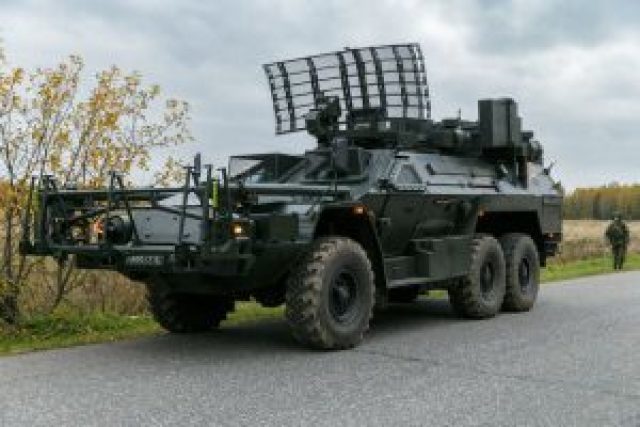
Image source: redstar.ru
– What is the total length of combat patrol routes in the positional areas of missile formations? How impressive are they in their area and where are they located?– The geography of the deployment of PGRK units of Strategic Missile Forces is quite extensive.
The divisions' positional areas are located on the territory of 15 regions of the Russian Federation from Tver to Irkutsk region.
The area of the positional areas of the compounds on average occupies about 75 thousand square kilometers. And the length of combat patrol routes in one positional area, passing along public roads and rough terrain, is more than six thousand kilometers.
– What priorities and tasks for the further development of Missile Forces will be reflected in the new State Armament Program until 2033?– Development of new modern types of strategic weapons with giving them new combat qualities that allow the Russian Federation to remain an advanced military-technical power and be ready to fend off any military threats.
– Sergey Viktorovich, what events of training troops in 2021 were particularly important? What was the specifics of combat training in the Strategic Missile Forces?– In the 2021 academic year, more than 1,500 combat training events of various levels were held, of which about 70 percent were devoted to tactical (tactical-special) and combined arms training.
Control complex checks of 100 percent of the RVSN compounds were carried out.
The retraining of the personnel of two missile regiments for new, promising strategic missile systems "Yars" in the Kozelsky and Barnaul missile formations has been completed.
All measures are important, have their own specifics and are aimed at maintaining formations, military units and units of the Strategic Missile Forces in constant readiness to perform tasks for their intended purpose.
– How are approaches to the exercises changing? How many exercises are planned to be held in 2022?– Special attention in the Strategic Missile Forces is paid to exercises as the highest form of combat training.
They not only check the level of training of management bodies and troops, but also improve the skills of combat training of personnel of formations, military units, divisions, the coherence of all management links.
In 2022, it is planned to conduct exercises in all formations, with the maximum involvement of military units and units of the units' departments. In total, more than 200 exercises of various levels will be held, 12 of which are command and staff exercises with missile formations. The largest will be the CSU conducted by the commission of the Command of the Strategic Missile Forces with the Yasnensky and Novosibirsk missile formations. The forces and means of military districts, types and branches of the armed forces will be involved in these exercises.
Along with these exercises, a large number of special exercises for all types of support have been additionally planned.
– Recently, the use of unmanned aerial vehicles has been rapidly introduced into combat training. How do you assess the prospects for the development of UAVs in the Strategic Missile Forces? How interested are strategic rocket scientists in drones?– For the first time, strategic rocket scientists used unmanned aerial vehicles eight years ago.
Since then, any significant combat training activities involve the use of UAVs. Command and staff exercises in re-equipped and re-equipped missile formations involve the use of a wide range of multifunctional unmanned aerial vehicles of different classes, including in various climatic zones and low temperature conditions.
Currently, 70 complexes from the composition of combat anti-sabotage vehicles BPDM "Typhoon-M" perform aerial reconnaissance tasks in the interests of protecting positional areas with the help of UAVs.
In the future, it is planned to further equip missile regiments with unmanned aerial vehicles of the airplane and copter type.
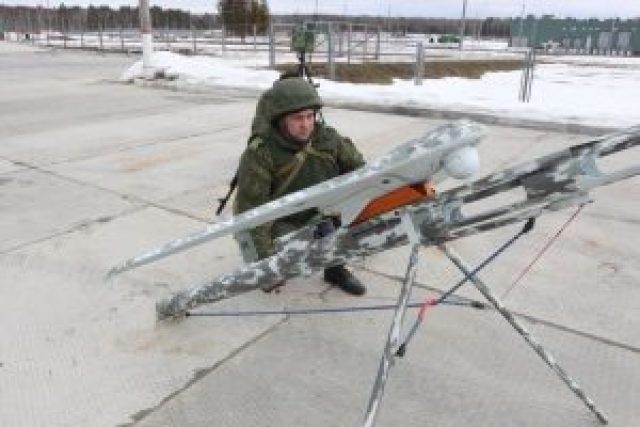
Image source: redstar.ru
– Are artificial intelligence technologies being introduced when creating promising types and models of Strategic Missile Forces weapons? Will they be used in the command and control system of troops and weapons, communications and data transmission?– In all developed strategic missile complexes of mobile and stationary basing, planned to be put on combat duty at the turn of the 2030s, automated security systems will be built only with the use of robotic complexes and the use of artificial intelligence.
The protection of RVSN facilities is already being considered as part of ensuring comprehensive security. These are the time requirements that must be taken into account when forming a promising appearance of the RVSN.
Since 2013, combat anti-sabotage vehicles have been supplied to the troops with remotely piloted aircraft on board and a remote-controlled weapons platform installed, as well as automated reconnaissance and alarm systems.
The use of robotic systems in the Armed Forces of the Russian Federation has been widely developed in recent years. Strategic Missile Forces are no exception, where military tests of military robotic complexes being developed are conducted on the basis of missile formations.
Currently, the tactical and technical characteristics of existing samples of military-purpose robotic complexes, due to the characteristics of Strategic Missile Forces, do not allow them to be used as separate samples. One of the areas of application of robotic systems is the protection and defense of objects of Strategic Missile Forces. At the same time, the integration of individual technologies into subsystems of existing and promising models of weapons, military and special equipment as support systems is of the greatest relevance.
In the interests of the Strategic Missile Forces, unmanned aerial vehicles, vision systems, target recognition, and situation analysis are being actively developed and implemented, including using artificial intelligence elements.
It is worth noting that the technologies being created will ensure reliable protection and defense of Strategic Missile Forces facilities.
– What are the robotic means for the RVSN security systems?– Robotic complexes for the protection of objects are already widely used in the RVSN.
Thus, as part of the automated systems for the protection of the launch positions of the strategic missile complexes "Yars" and "Avangard", a remote-controlled firing complex "Smoke-2" is used, which is capable of functioning both autonomously and under the control of an operator. The complex provides visual surveillance of the controlled area, is equipped with a thermal imager, various technical means of protection.
Stationary combat modules are equipped with grenade launchers, automatic small arms and can conduct targeted fire in a circular firing sector.
The Kozelsky Missile Division became the first unit whose missile regiments received a new generation of protection systems. As part of strategic missile systems, 28 sets of such systems have been delivered to the troops over the past six years.
The automated security system for the promising strategic missile complex "Sarmat" will also use a remote-controlled turret-machine gun installation, for the functioning of which elements of neural networks and human and object recognition systems are involved.
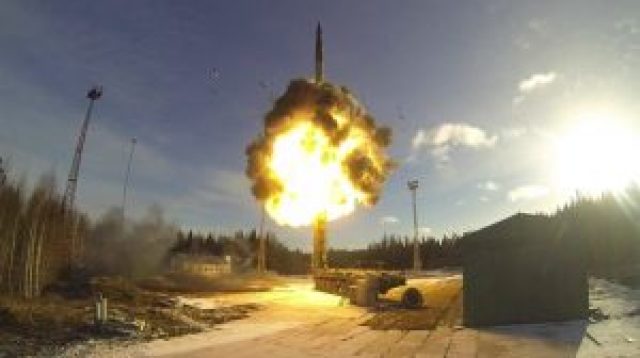
Image source: redstar.ru
– One of the components of the combat capability of the Strategic Missile Forces is the possibility of neutralizing the DRG in the positional areas of missile divisions, if they are thrown there by the enemy. What do strategic rocket scientists have to accomplish this task?– The Strategic Missile Forces has developed a system of organizing the protection and defense of facilities, which guarantees that sabotage and reconnaissance or terrorist groups will not penetrate them.
The defense of the Strategic Missile Forces' positional areas is built in echelon, according to the principles of a combination of zonal-object cover from the entire range of means of air attack and direct protection of objects in the areas of deployment of missile formations from sabotage and terrorist formations.
Currently, the direct physical and anti-terrorist protection of the objects of the Strategic Missile Forces is provided by the use of automated security systems in conjunction with sets of technical security equipment. The capabilities of automated security systems are expanding primarily due to the use in their composition of means of detecting and defeating low-flying small-sized targets such as reconnaissance UAVs and means of overcoming obstacles by air.
– Do the cadets of the RVSN universities study robotic systems?– The Military Academy of the Peter the Great Strategic Missile Forces maintains a leading position among military universities in Russia, including in the training of specialists in the field of robotics.
For the first time in the country, the federal state educational standard "Robotics for military and special purposes" was developed in it, and in 2020, cadets began training on it. This academic year, many leading technical universities have started preparing students for it.
By studying in this specialty, our graduates acquire basic competencies in the operation of strategic missile weapons and will be able to master existing and promising robotic systems.
– Most higher military educational institutions dream of having the same magnificent base as the Military Academy of the Peter the Great Strategic Missile Forces. How high is the competition for this educational institution?– We are proud of our academy.
Since 2015, after moving to new funds exceeding 64 hectares in area, it has been actively building up the educational and material base. This year, the commissioning of the Academy's teaching and laboratory building has been completed, more than 100 classrooms have been commissioned. The provision of the university with modern educational and training facilities is 96 percent. All this makes it possible to train rocket specialists with the necessary qualifications, the quality of training of which is not inferior to the leading technical universities of the country.
The recruitment volume remains high, about 1000 people. Therefore, it is not particularly difficult for a young person motivated to study and further service in the RVSN to enter our university. Professional selection of candidates for admission is carried out both directly at the universities of the RVSN, and by their visiting groups in Rostov-on-Don and Perm.
Every year, the academy accepts 10 girls for the specialty "Application and operation of special-purpose information and analytical systems". The competition there is very high, varies between nine and ten people per place. As a rule, medalists come in with excellent USE scores and a high level of physical fitness.
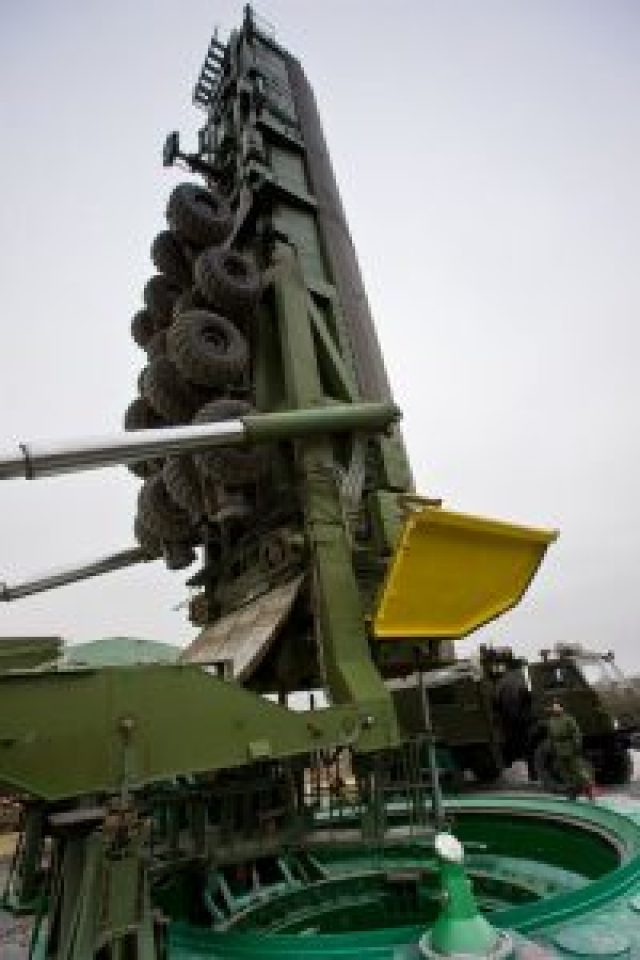
Image source: redstar.ru
– Tell us more about the training of young officers. At what level do young lieutenants come to you, how is their further training organized? What practical experience have they already gained?– In the modern conditions of the formation of a professional army, its rearmament with new models of weapons and military equipment in the troops, the requirements for the quality of training of young officers are increasing.
In 2021, about 1,000 officers – graduates of higher military educational institutions of the Ministry of Defense of the Russian Federation arrived in the Strategic Missile Forces, who were gradually introduced into the officer corps of combat units and divisions.
The command of formations and military units, the best and most experienced specialists conducted a set of classes with young officers both in their specialty and on issues of daily activities. Starting from the meeting of graduate officers and their wives with the command of formations, familiarizing them with the traditions of formations and units, studying weapons, military equipment on combat duty, and ending with admission to combat duty as combat crew numbers.
This approach makes it possible to ensure their formation as military officers, instill an interest in further improving military theoretical knowledge, practical skills in the skillful management of units and possession of weapons and military equipment.
Practice shows that out of the total number of university graduates arriving in the Strategic Missile Forces, more than 70 percent of young officers are assigned directly to combat crews and are on combat duty. In this regard, the training is carried out in a differentiated manner.
The army has created a system for the formation of a young officer in accordance with his regular position. We are constantly improving the mechanism for commissioning lieutenants, applying new methods and approaches to their stimulation. Each of the graduates is assigned an experienced officer-mentor, whose task is to provide assistance during the formation period.
In missile formations, the tradition of announcing orders by the command of formations (units) on the admission of graduate officers to combat duty and encouraging young officers in a solemn atmosphere before the formation of the entire compound (military unit) has been established. Also in the Strategic Missile Forces, there are unshakable traditions in the admission of graduates to the combat ranks of the officer corps. In all guard formations, initiation into the "guards" is held with the presentation of badges.
Young officers graduating in 2021 are currently mastering new models of the RKSN as part of their units. These are the Yars mobile and stationary-based missile systems, the Avangard stationary-based missile system, and the Sarmat missile system is being prepared for combat duty.
Considering the future perspective, it is safe to say that the nuclear shield of the Motherland is in safe hands. Young rocket officers, absorbing the traditions of the older generation, studying and mastering new models of weapons and equipment, adequately ensure the serviceability and combat readiness of formidable weapons.
– Who is in the RVSN in the forefront? Who should the others look up to? Maybe there are new shock military units or divisions in the troops?– According to the results of the 2021 academic year, the best results were achieved and are our leaders: the Vladimir Association (Commander – Major General Oleg Glazunov); the Teikovo compound (Commander - Major General Farid Shigmardanov) and the Uzhur compound (Commander – Major General Yuri Dry).
The missile regiment of the Yoshkar-Ola compound (commander – Colonel Alexey Kuklin) was awarded with the passing pennant of the commander of the Strategic Missile Forces "For military valor, high performance and excellent combat training". The 47th Interregional Training Center (head - Colonel Alexey Kuzminykh) was recognized as the best military training unit. The best association, formations and military units were awarded with passing pennants at the end of the year.
This year, eight shock military units have been trained (six of them for the first time) and 14 units of battalion and company composition (nine of them for the first time). The training of shock military units and subunits will continue next year.
– What would you wish your subordinates, and not only them, on the eve of the holiday?– On behalf of the Military Council of the Strategic Missile Forces and myself, I congratulate the personnel, veterans, scientists, designers on our professional holiday – the 62nd anniversary of the formation of the Strategic Missile Forces!
Today, as many years ago, the Strategic Missile Forces are the guarantor of the national security of our country. The current Strategic Missile Forces are a well–coordinated combat organism, armed with the most modern models of weapons and military equipment. Thanks to the selfless military work of rocket warriors, the high quality and reliability of the latest strategic missile weapons, a well-coordinated combat duty system, the troops successfully solve the most important tasks to strengthen the defense capability of the state.
I express my gratitude to all the personnel of the Strategic Missile Forces for the dedication, dedication and perseverance they show in carrying out their tasks.
I wish the personnel, veterans, creators and testers of rocket technology, your families good health, happiness and well-being, confidence in the future, high achievements in service and work for the benefit of our country.
Roman BIRYULIN, "Red Star"Dmitry ANDREEV
